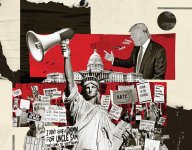The Great Pitch for Simultaneity
The central government’s push for “One Nation, One Election” has been sold as a revolutionary solution to India's electoral fatigue and governance paralysis. The idea is simple: hold elections to the Lok Sabha and all state assemblies simultaneously. Proponents argue it will save money, reduce policy paralysis, and ensure continuity in governance. But beneath this sheen of efficiency lies a deeper concern—does this undermine the federal spirit of India’s democracy?
Democracy at the Convenience of Power
Critics argue that simultaneous elections are less about efficiency and more about consolidating power. Regional voices get drowned out in a national narrative dominated by central parties. State elections currently allow voters to make issue-based decisions relevant to their context. With one mega election, national issues and personalities will overshadow regional dynamics, harming local democracy.
A Blow to Federalism
India’s federal structure thrives on staggered elections. They provide checks and balances—states can push back when the Centre overreaches. One Nation, One Election risks flattening this delicate balance, centralizing authority under the guise of unity. Smaller parties fear extinction, and regional dissent becomes harder to express in a homogenized electoral environment.
The Logistics Illusion
Supporters cite cost-cutting and logistical ease. But is democracy supposed to be cheap or representative? Staggered elections distribute the burden on security forces, judiciary, and election officers. A single-shot national election could overwhelm the system and lead to greater malpractice, not less.
Constitutional Quicksand
Implementing this idea requires massive constitutional amendments, the dissolution or extension of several state assemblies, and unprecedented political consensus—none of which currently exists. It raises uncomfortable questions: who decides when a state’s term should end early? What happens in the case of a midterm collapse of a state government?
Control Over Conversation
Let’s not ignore the most potent political weapon this reform offers—the power to control the national conversation. A simultaneous election creates a monolithic media narrative, easier for dominant parties to manipulate. Election cycles currently allow opposition voices to remain in the news year-round. One cycle shuts that down.
Conclusion: Reform or Regression?
While the façade of One Nation, One Election is built on administrative convenience and economic rationale, its core tilts dangerously toward centralization, uniformity, and control. Democracy is messy by design; trying to streamline it often comes at the cost of its very essence. What India needs isn’t synchronized elections—it’s a stronger commitment to federalism, diversity, and genuine decentralization of power.
The central government’s push for “One Nation, One Election” has been sold as a revolutionary solution to India's electoral fatigue and governance paralysis. The idea is simple: hold elections to the Lok Sabha and all state assemblies simultaneously. Proponents argue it will save money, reduce policy paralysis, and ensure continuity in governance. But beneath this sheen of efficiency lies a deeper concern—does this undermine the federal spirit of India’s democracy?
Democracy at the Convenience of Power
Critics argue that simultaneous elections are less about efficiency and more about consolidating power. Regional voices get drowned out in a national narrative dominated by central parties. State elections currently allow voters to make issue-based decisions relevant to their context. With one mega election, national issues and personalities will overshadow regional dynamics, harming local democracy.
A Blow to Federalism
India’s federal structure thrives on staggered elections. They provide checks and balances—states can push back when the Centre overreaches. One Nation, One Election risks flattening this delicate balance, centralizing authority under the guise of unity. Smaller parties fear extinction, and regional dissent becomes harder to express in a homogenized electoral environment.
The Logistics Illusion
Supporters cite cost-cutting and logistical ease. But is democracy supposed to be cheap or representative? Staggered elections distribute the burden on security forces, judiciary, and election officers. A single-shot national election could overwhelm the system and lead to greater malpractice, not less.
Constitutional Quicksand
Implementing this idea requires massive constitutional amendments, the dissolution or extension of several state assemblies, and unprecedented political consensus—none of which currently exists. It raises uncomfortable questions: who decides when a state’s term should end early? What happens in the case of a midterm collapse of a state government?
Control Over Conversation
Let’s not ignore the most potent political weapon this reform offers—the power to control the national conversation. A simultaneous election creates a monolithic media narrative, easier for dominant parties to manipulate. Election cycles currently allow opposition voices to remain in the news year-round. One cycle shuts that down.
Conclusion: Reform or Regression?
While the façade of One Nation, One Election is built on administrative convenience and economic rationale, its core tilts dangerously toward centralization, uniformity, and control. Democracy is messy by design; trying to streamline it often comes at the cost of its very essence. What India needs isn’t synchronized elections—it’s a stronger commitment to federalism, diversity, and genuine decentralization of power.

